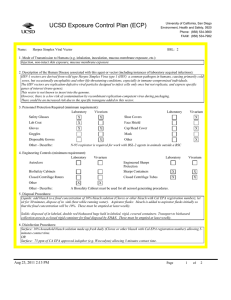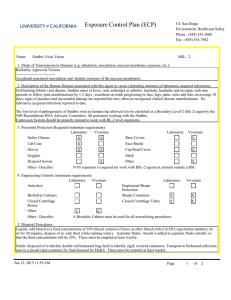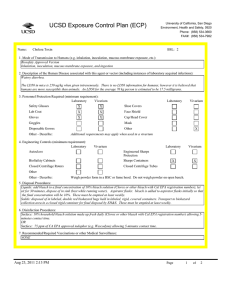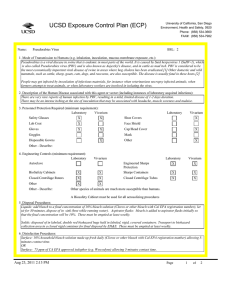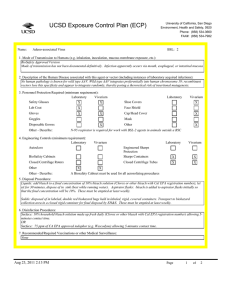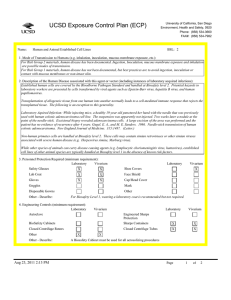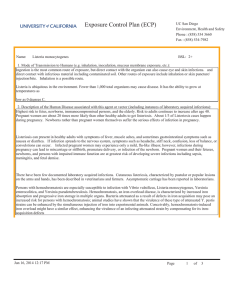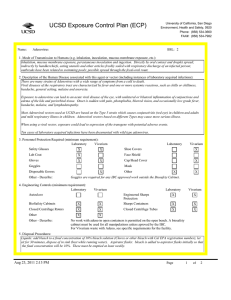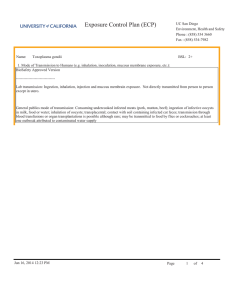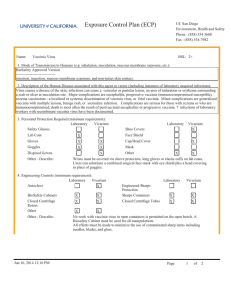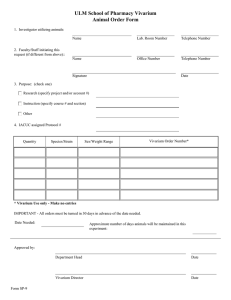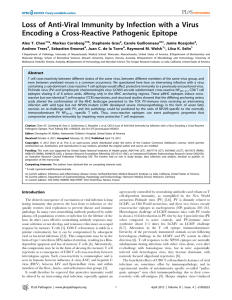Exposure Control Plan (ECP)
advertisement
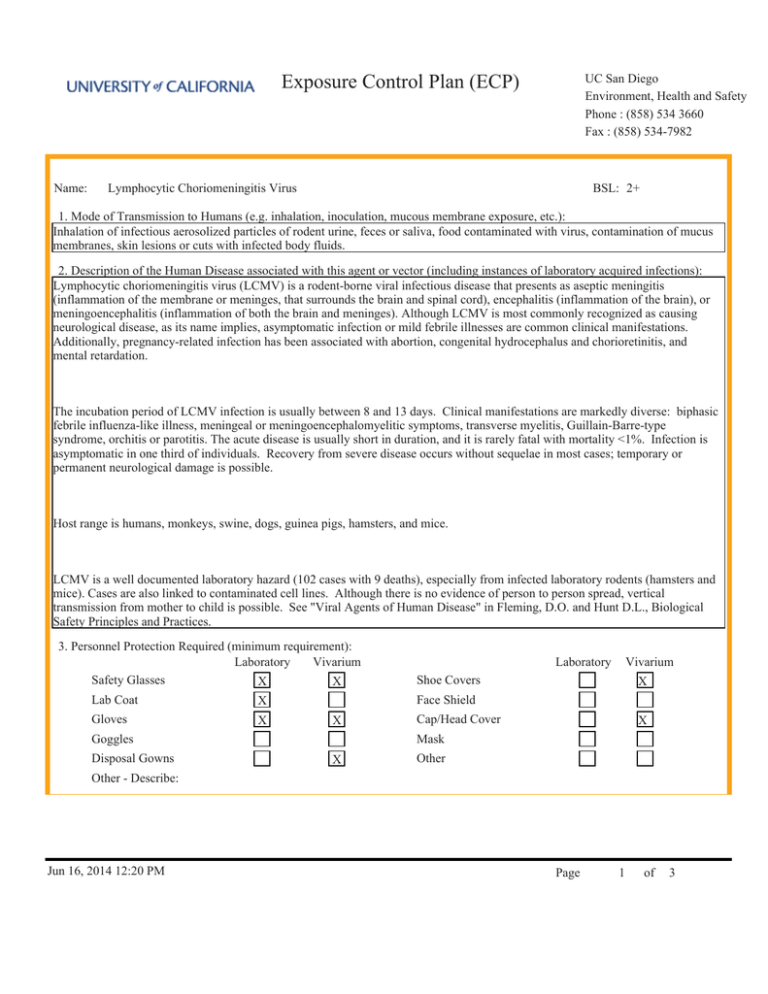
UC San Diego Environment, Health and Safety Phone : (858) 534 3660 Fax : (858) 534-7982 Exposure Control Plan (ECP) Name: Lymphocytic Choriomeningitis Virus BSL: 2+ 1. Mode of Transmission to Humans (e.g. inhalation, inoculation, mucous membrane exposure, etc.): Inhalation of infectious aerosolized particles of rodent urine, feces or saliva, food contaminated with virus, contamination of mucus membranes, skin lesions or cuts with infected body fluids. 2. Description of the Human Disease associated with this agent or vector (including instances of laboratory acquired infections): Lymphocytic choriomeningitis virus (LCMV) is a rodent-borne viral infectious disease that presents as aseptic meningitis (inflammation of the membrane or meninges, that surrounds the brain and spinal cord), encephalitis (inflammation of the brain), or meningoencephalitis (inflammation of both the brain and meninges). Although LCMV is most commonly recognized as causing neurological disease, as its name implies, asymptomatic infection or mild febrile illnesses are common clinical manifestations. Additionally, pregnancy-related infection has been associated with abortion, congenital hydrocephalus and chorioretinitis, and mental retardation. The incubation period of LCMV infection is usually between 8 and 13 days. Clinical manifestations are markedly diverse: biphasic febrile influenza-like illness, meningeal or meningoencephalomyelitic symptoms, transverse myelitis, Guillain-Barre-type syndrome, orchitis or parotitis. The acute disease is usually short in duration, and it is rarely fatal with mortality <1%. Infection is asymptomatic in one third of individuals. Recovery from severe disease occurs without sequelae in most cases; temporary or permanent neurological damage is possible. Host range is humans, monkeys, swine, dogs, guinea pigs, hamsters, and mice. LCMV is a well documented laboratory hazard (102 cases with 9 deaths), especially from infected laboratory rodents (hamsters and mice). Cases are also linked to contaminated cell lines. Although there is no evidence of person to person spread, vertical transmission from mother to child is possible. See "Viral Agents of Human Disease" in Fleming, D.O. and Hunt D.L., Biological Safety Principles and Practices. 3. Personnel Protection Required (minimum requirement): Laboratory Vivarium Safety Glasses X X Lab Coat X Gloves X X Goggles Disposal Gowns Laboratory Vivarium X Shoe Covers Face Shield Cap/Head Cover X Mask X Other Other - Describe: Jun 16, 2014 12:20 PM Page 1 of 3 Exposure Control Plan (ECP) 4. Engineering Controls (minimum requirement): Laboratory Vivarium Autoclave X BioSafety Cabinets X X Engineered Sharps Protection Sharps Containers Closed Centrifuge Rotors Other X X Closed Centrifuge Tubes Other - Describe: Laboratory Vivarium X X X X X X No work with LCMV in open containers is permitted on the open bench. A biosafety cabinet must be used for all manipulations. 5. Disposal Procedures: Liquids: add bleach to a final concentration of 10% bleach solution (Clorox or other bleach with Cal EPA registration number), let sit for 30 minutes, dispose of in sink (best while running water). Aspirator flasks: bleach is added to aspirator flasks initially so that the final concentration will be 10%. These must be emptied at least weekly. Solids: disposed of in labeled, double red biohazard bags held in labeled, rigid, covered containers. Transport to biohazard collection area in a closed rigid container for final disposal by EH&S. These must be emptied at least weekly. 6. Disinfection Procedures: Surface: 10% household bleach solution made up fresh daily (Clorox or other bleach with Cal EPA registration number) allowing 5minutes contact time. OR Surface: 75 ppm of CA EPA approved iodophor (e.g. Wescodyne) allowing 5-minutes contact time. 7. Recommended/Required Vaccinations or other Medical Surveillance: All personnel in the laboratory are required to document that they have read this ECP prior to the use of LCMV in the laboratory. The PI and individuals doing the research must verify that everyone is aware when LCMV is going to be used. This includes informing all members of the laboratory as well as any individual not associated with the lab that enters this space. All women in the laboratory with childbearing potential working with LCMV, are required to be counseled through Center for Occupational and Environmental Medicine (COEM) or the campus Occupational Health Nurse (x48225) as to the increased risk to a fetus and newborn. All personnel have the option to be counseled through Center for Occupational and Environmental Medicine (COEM) or the campus Occupational Health Nurse (x48225). 8. Employee Exposures- first aid procedures: a. Eye exposure from splash or aerosols - rinse a minimum of 15 minutes in eye wash or flush area with water. b. Skin exposure - wash area with soap and water for 15 minutes c. Needle stick and/or sharps exposure - wash wound area with soap and water for 15 minutes d. Contamination of clothing - remove the contaminated clothing and place in biohazard bag, shower with the emergency douse shower, and put on clean clothes. e. Spill or release - Monday through Friday, 8a - 4:30p call EH&S; after hours call Campus Police Jun 16, 2014 12:20 PM Page 2 of 3 Exposure Control Plan (ECP) 9. Employee Exposure - seek medical follow-up from the following medical providers: (TAKE THIS ECP WITH YOU) 24-hour walk-in service: Hospital Emergency Room Or nearest Medical Center Emergency Room Call your campus Occupational Health contact to determine if a follow up visit is required. Most exposures will require a visit to Occupational Health. Monday - Friday, 8a - 4:30p 10. Report All Injuries, Illnesses, and Exposures to EH&S: Report the injury incident to their immediate supervisor and complete your campus injury report form 11. Required Biosafety Training: Laboratory specific training on hazards, exposure evaluations, and the required precautions for experimental procedures used with this agent - provided by Principal Investigator 12. Lab specific instructions: Jun 16, 2014 12:20 PM Page 3 of 3
